
PLENTY of people say never look back, only look forward. I have never heeded that advice. I’m always replaying events, both good and bad; I remember slights from decades ago. I never forget, but I forgive. Back in 2017, I scanned in a number of photos from the dawn of the Forgotten NY era, from 1998-2001. Back then, I was photographing things that still existed but New Yorkers seemingly hadn’t noticed them or didn’t care about them.
Fortunately, there are plenty of people who do care and this little website is still going nearly 25 years later, with more than 150 live tours, a number of personal radio and TV appearances (one night I staggered into a hotel room in Calgary to find myself on the TV news speaking at a confab about the reuse of alleyways (not sure if the king of CTV News, Lloyd Robertson, introduced the segment; I should have worn a better shirt) two books and a chapter and newspaper articles (I once appeared “above the fold” in the NY Times; below the fold were David Brooks and Paul Krugman.)
When I began photographing for Forgotten NY I was a rank amateur and didn’t know how to get the best possible shot. I am still a point and shoot photographer and haven’t realized the potential of my digital cameras and IPhone cameras. Nevertheless, my technique was good enough that I photographed everything in Forgotten New York The Book from 2006 (the HarperCollins production crew snazzed things up and gently retouched some material). But the passage of time has rendered these pictures an added effect of regret since many of them have disappeared in the 25 years since I first grabbed them.
You’ll also notice vivid Kodachrome colors here; digital photos have a flatness to them, and while I do retouch in Photoshop occasionally, I can’t get these kind of bright colors without laboring in the digital world longer than I want to.

The jazz club/restaurant Lenox Lounge held forth at 288 Lenox Avenue (Malcolm X Blvd) just south of West 125th (Martin Luther King, Jr. Blvd.) from 1939 to 2012, along the way helping to launch the careers of Billie Holiday, John Coltrane and Miles Davis. It had its original red-paneled Art Deco exterior until its closure; I’m not sure when the distinctive neon sign was added.
The Lenox Lounge has been shuttered since late 2012 and the neon sign is gone. The owner since 1988, Alvin Reid, Sr., had removed it and had hoped to reinstall it on a new location at 333 Lenox above 125th Street, but that never came about. In 2023, a Wells Fargo bank occupied the site.

I featured McHale’s, formerly at 8th Avenue and West 46th in Hell’s Kitchen, in FNY’s Neon Nights page in 2006.
Jennifer 8. Lee wrote in the NY Times:
“In a city of $15 cosmopolitans, McHale’s sells $4 pints of beer and Ketel One and tonic for $4.50. The burgers are so thick that they crumble under their own weight.
With its darkened windows and aging neon lights, the restaurant is invisible to all except those who already know it, a shared secret for the stagehands, neighborhood regulars and the khaki-clad types who work at Viacom and Morgan Stanley in Times Square. Its intimacy embraces newcomers, taking some by surprise. “I walked in the other day, and they’re like, ‘Hey, Brian, what do you want?’ and I’m like, ‘What? You know my name?’ ” said Brian Silverman, 29, a guitarist on “Movin’ Out,” playing across the street.
The pub is an oasis that has so far escaped the sweep of Times Square development. “Times Square should change with the times, but I think it’s become too commercial and too Disney World,” said Tyler Miller, 32, a messenger who has been coming to McHale’s for six years. “It’s nice to have something from the past.”
The bar still has some original windows from the days when it was called the Gaiety Cafe. The wooden bar is from the 1939 World’s Fair. The blinds were installed for an American Express commercial with Jerry Seinfeld that was shot two years ago.”
Soon after McHale’s closed, I found the old McHale’s neon signs on a sidewalk in front of an antiques shop on West 24th. At least some of it found its way to a new McHale’s at #251 West 51st Street.

While shuffling past a grand old brick factory building on Bridge and Front Streets in DUMBO, Brooklyn, I noticed scaffolding protecting the sidewalk, a sure sign of renovation.
I noted with dismay that the pair of hand-lettered signs on the corner saying STAR FASTENER DELIVERY etc. that had been there for decades had been blasted away as part of an overall repointing of the exterior. In a neighborhood where one owner recently repainted the words THOMSON METER CO. WATER METERS on a nearby building, even though the manufacture of water meters had long ago ceased in the building, as an ironic counterpoint to the building’s recasting in residential units, you might think the old signs would have been preserved, but different strokes, etc.
By 2023, most of DUMBO’s old factory buildings have been converted to luxury residential buildings; at least they have been left intact and are mostly unchanged on the outside. Today, only a very faded Modern Box painted sign can be seen on this building, #54 Bridge Street, known for a long time as the Hanan Building, occupied by a shoe manufacturer.
The Hanan Company was among the first to stamp the firm’s name on every shoe, a daring idea at a time when most people still sought shoes handmade by the dealer. The firm was successful and in 1888 Hanan began opening retail stores to sell the factory’s product directly to consumers.
This factory was built in 1893. By 1913 the company employed 1,131 people in its Brooklyn factory (871 men, 210 women, and 50 office workers). John Hanan also owned shoe companies in other cities and served as president of the National Boot and Shoe Manufacturers’ Association.
Hanan went bankrupt in 1935 and the building was used by other manufacturers until its recent conversion to residential.

I took this photo at the entrance to the R train at Clinton and Montague Streets at St. Ann’s Church during a snow storm on December 30, 2000. Inexplicably, a pair of BMT subway indicator lamps had remained in place for decades. Such lamps indicated BMT lines by green glass and IRT trains by blue glass. Alas, within a few years these had disappeared (I hope they made their way to the NYC Transit Museum collection) and replaced by green and white lamps, indicating that subway access was available 24/7.
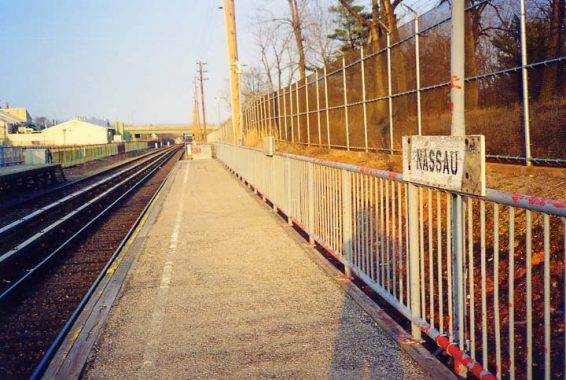
If you didn’t know any better, you might think this bare-bones railroad platform is in Nassau County, given the crude wood stenciled signs. Instead, it was named for the Nassau Smelting & Refining Co.’s plant, built in 1900 on the Richmond Valley line of Tottenville. The smelting works (Tottenville Copper Company) was bought by Western Electric in 1931 as a result of the Depression. In 1971 it became a metal recycling plant and renamed Nassau Recycling Corporation. It is now a part of Lucent Technologies. A nearby station, Atlantic, was named for the Atlantic Terra Cotta Company, once one of Staten Island’s largest employers, who made the decorative materials used on skyscrapers (including the Woolworth Building, Coney Island’s Child’s Restaurant, and Philadelphia Museum of Art) and for fire-resistant cladding. The company’s smokestack was a familiar Tottenville landmark for 80 years until 1988 with the demolition of the 135-foot structure.
Both stations were torn down and are now without trace, as a new station midway between the two, Arthur Kill, was constructed and opened in 2017.
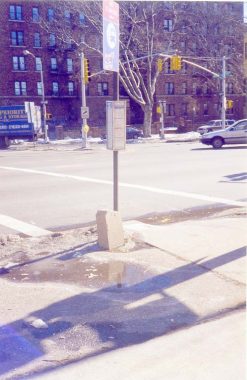
In Forgotten NY’s early days I was on a Sunday outing with Uni-Watch’s Paul Lukas in southern Brooklyn and we happened upon this stone marker at the corner of Ocean Parkway and Neptune Avenue. On the side facing the street was the carven numeral “5.” As it turned out this was a remaining Ocean Parkway milestone marker.
Ocean Parkway was built between 1874 and 1880 in mid-Brooklyn from Prospect Park south to Coney Island. A milestone was placed every half mile, but over the decades, every one had disappeared or had been removed by 2000 except the 3-mile marker, south of Avenue P, and the 5-mile marker here. Today only the 3 mile marker remains.
Bklyner has more including research by me and by Gravesend’s Joseph Ditta; and Ditta produced a map showing the original locations of the milestones based on research by Richard J. Koke. Here’s a look at the 1.5 mile marker.

Here’s a signal stanchion on the defunct Long Island RR Rockaway Branch near Liberty Avenue. When I happened by in 2000, one of the local youths had hung a giant spider contraption on it that must have fooled some of the more gullible area residents.
In 2000 there were discussions about whether to make the old RR a large linear park (Queensway) or revive it as a transit line connecting the Queens Boulevard IND and the A train to the Rockaways. These discussions are still ongoing. Neither of these proposals will ever bear fruit.
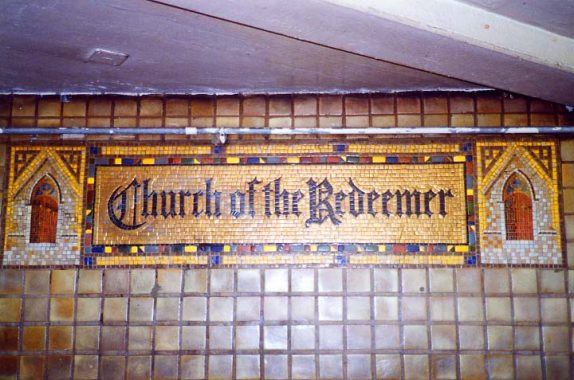
Here’s a beautiful mosiac sign for the Church of the Redeemer. It can be found on the staircase on the NW corner of Pacific Street and 4th Avenue, at the Barclays Center station (formerly known as Pacific Street on the BMT 4th Avenue line, serving R and N trains and connecting with IRT and IND lines.
It’s a sign without a church, though, as the Episcopal Church of the Redeemer, constructed in 1866, was torn down after an even 150 years in mid-2016. Full story here.

I live about a block away from the only road north of Northern Boulevard that connects Douglaston and Little Neck. It runs just north of the LIRR tracks through Gabbler’s Creek Ravine between Douglas Road and Little Neck Parkway, and is not on official city maps. Area residents call it “the back road” while homes nearest Little Neck Parkway have 39th Avenue addresses, one house further west has a Sandhill Road address, and a DOT street sign on Douglas Road tabs it “Bayshore Boulevard.”
Until 2010 or so, a nonstandard sign, possibly fashioned by an era resident in the former Queens street sign colors of blue and white, labeled it Sandhill Road; but the DOT probably was alerted about it and removed it.
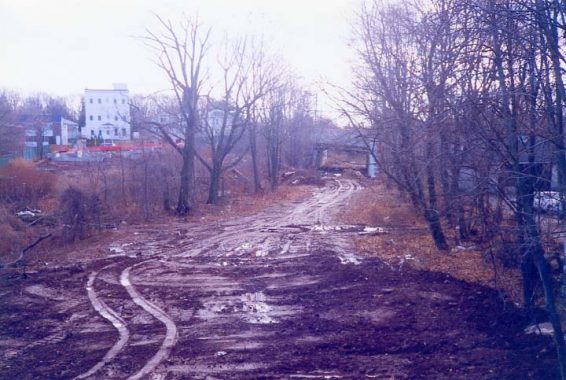
In 1999 I was walking in Rosebank (Staten Island) near Fingerboard Road in the vicinity of Tompkins Avenue when I spotted this muddy stretch of empty ground. It wasn’t a road under construction. Instead, it was a remaining unbuilt-on segment of the South Shore Branch of Staten Island Rapid Transit, now known as Staten Island Railway. The railroad formerly had three branches, the main branch to Tottenville, still running today; a branch along the north shore to Arlington; and the South Shore branch to South Beach. The latter two were closed down in 1953, and most traces of the South Shore Branch have now been filled by tract housing.
Musician Gary Owen, now living in Europe, assembled historic images of the SIRT into a comprehensive website a couple of decades ago. Here is the South Shore page.
There have been three major types of stoplight posts employed in NYC since the 1920s. One is the “Wheelie” stoplight, so called because a car wheel was part of its castiron ornamentation; the short “Olive” stoplights placed catercorner at many intersections until they were decommissioned in the 1980s; and the large, thick-shafted guy wired stoplights that began to phase out the Wheelies beginning in the 1950s.
However, a simpler, cruder version of the Guywire occasionally popped up. They may have been meant as temporaries until a Guywire could be shipped in. There were a pair of the “Guywire Lites” at Church Street and Park Place for a number of years, as well as one at a pedestrian crossing at the Henry Hudson Parkway near the George Washington Bridge. All of these are no longer there.

In the summer of 1999 or 2000 I was riding down Brooklyn’s Broadway El, of course riding in the front car of the R-40 so I could see out the front of the “railfan window,” and I got this shot of an exceedingly ancient ad which was, I think, in the vicinity of the Kosciuszko Street station on the east side of Broadway. I doubt it’s there any more. The ad was for a pain remedy, “Dr. Tucker’s “59” available from the 1880s into the early 1900s. I gather it was discontinued because one of its chief ingredients was cocaine; Coca-Cola was forced to remove whatever coca extraction it had around this time, as well.
The best shot of this sign came from the narrow walkway on the side of the tracks. That’s where Fading Ads man Frank Jump got his optimal shot of the ad at around the same time. Frank was on ForgottenTour #1 on June 1, 1999 when ForgottenFans saw several other exceedingly old painted ads under the el on Broadway; most have been painted over now, as gentrification creeps in.
Dr. Tucker’s 59 Cough Drops [Smithsonian]
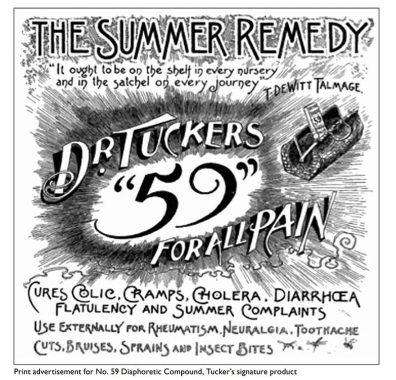
Harrison Allen Tucker (1832-1894), from Martha’s Vineyard, was a self-described clairvoyant and patent medicine inventor; the number 59 on his pain medication (mostly alcohol-based, with cocaine and opium added) was simply his 59th medication he formulated after 58 others. His complete story can be found on Page 21 of the Winter 2016 Dukes County Intelligencer.

Origunal “Type F” lampposts are hard to find in NYC now; there are a pair at the 26th Avenue footbridge over the Belt Parkway in Bensonhurst, and one on West 13th Street between 6th and 7th Avenues in Greenwich Village. However, retro versions have popped up on 8th Street in the Village and on Wuckoff and Metropolitan Avenues in Brooklyn and Queens, among other places.
Twin Type Fs were rarer at least by the 1990s. this one could be found at the east end of East 58th Street, also known as Sutton Square in the shadow of the Queensboro Bridge. It was replaced with a retro Bishop Crook soon after this photo was taken in 2000. Other Twin Type Fs could be found on the SUNY Maritime campus in Throgs Neck. Linden Boulevard in Brooklyn and on Rockaway Boulevard in southeast Queens, but those are also long gone.
As always, “comment…as you see fit.” I earn a small payment when you click on any ad on the site. Take a look at the new JOBS link in the red toolbar at the top of the page on the desktop version, as I also get a small payment when you view a job via that link.
10/15/23


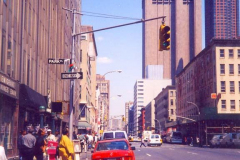
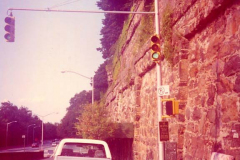
7 comments
Thanks for everything you do Kevin. Some of my favorite subjects here.
If i remember correctly, there was a McHales bar in Astoria also, i think on Broadway in the 30’s.
And the 1 house on Sand Hill Rd had something to do with the Douglas Manor Association. What , i don’t remember. Maybe they had some sort of co-op up the hill in the manor. I’m going back 40 yrs ago
Coca Cola still puts cocaine in its soda,though the company would probably not like that
to get out.They import Coca leaves from Peru which first goes to a pharmaceutical
company in N.J. which takes out the part that gets you high from the leaves.Its the flavor
imparted from the leaves that Coca Cola is after and so now you know at least one of the
famous secret ingredients that make up Coke thats kept in a safe in Atlanta,Ga.all rights
reserved,Amen.
When dealing with questions about corporate secrets, especially something like the Coca-Cola ingredients, the best answer would be: “I could tell you more but then they’d have to shoot both of us”. Tread lightly.
I’m not worried about it.Its practically common knowledge.The name of the company that
processes the coca leaves is the Stepan company of Maywood N.J.
Unfortunately, even some of the remote parts of NYC weren’t immune to homogenization over the years.
According to Research Gate, Doctor Tucker was a Claivoyant and Spiritualist who lived, worked, and ‘Miracled’ in the City Of Brooklyn. He wrote a booklet called the ‘Manual of Dr. H.A. Tucker’s Specific Family Remedies, With Hygienic Suggestions’ in 1873. It contained 58 ‘patent medicines,’ as well as his best known “Diaphoretic Compound,’ the golden 59th. It was later found to be mostly alcohol, with cinnamon oil and anise (Number 64 contained opium.)